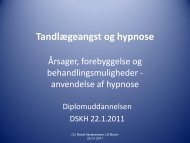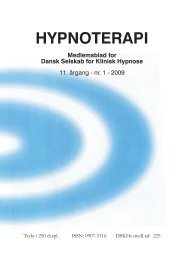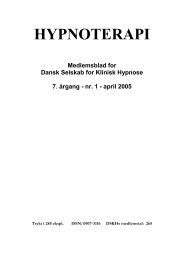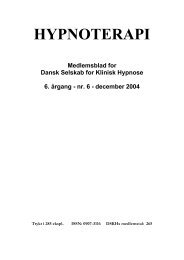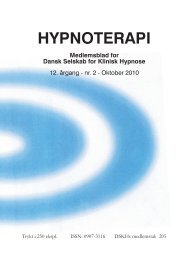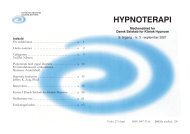HYPNOTERAPl - Dansk Selskab for Klinisk Hypnose
HYPNOTERAPl - Dansk Selskab for Klinisk Hypnose
HYPNOTERAPl - Dansk Selskab for Klinisk Hypnose
Create successful ePaper yourself
Turn your PDF publications into a flip-book with our unique Google optimized e-Paper software.
The following summarizes our experience and discusses both the theory and our rationale<br />
as to the results achieved, since they seem to differ from teachings and admonitions of a<br />
number of very respected colleagues (Brende & Benedict, 1980; Brown, 1990; Brown &<br />
Fromm, 1986; Chu, 1998; Fromm & Nash, 1997; Horowitz, 1986; Phillips & Frederick, 1995;<br />
Ross, 1989; Spiegel, 1981; van der Hart and Brown, 1992; van der Kolk and van der Hart,<br />
1989; Wolberg, 1948). These contributors apparently feel it is a much more dangerous<br />
procedure than we have found it to be, and they advise a more cautious approach to it. We<br />
fully recognize that any therapeutic procedure which is strong enough to help can harm if<br />
mishandled, and this principle certainly applies to abreactions.<br />
During the many abreactions conducted by us with the dissociative and child abuse cases,<br />
which characterized much of Helen's ego state therapy practice <strong>for</strong> the past 25 years, we did<br />
not find one of these patients breaking into a psychotic reaction, nor was there any evidence<br />
in which the abreaction itself re-traumatized the patient (Watkins and Watkins, 1997). We<br />
have been repeatededly asked why such results - often with skepticism. We also wanted to<br />
know why.<br />
We cannot ascribe the favorable results simply to good luck, nor do we make any claim to<br />
being miraculous therapists. There must be some other reasons that are the determining<br />
factors, perhaps in how we envision the term "abreactions," and specifically how we conduct<br />
them.<br />
Although Freud (1958) initially found abreactions therapeutic, he eventually abandoned<br />
them <strong>for</strong> the slower psychoanalytic methods which emphasized the initiation and workingthrough<br />
of transference reactions. We wonder whether the <strong>for</strong>ebodings presented in so much<br />
of the literature stem from Freud's theories, or from actual disastrous abreactions, experienced<br />
by patients of the writers themselves.<br />
THE NATURE AND PSYCHODYNAMICS OF ABREACTIONS<br />
The "abreaction" is a re-living, a re-experiencing, of an emotionally traumatic event which<br />
appears to have become fixated in an intra-psychic conflict resulting in painful and<br />
incapacitating symptoms. The patient is bound up in this event, unconsciously if not<br />
conscious-ly, and is not able to extricate himself from it and gain closure. The traumatic<br />
event, even though it may have occurred some time in the past (perhaps many years ago),<br />
continues to exist within the patient's psyche. To be resolved it must be re-experienced and<br />
mastered. That word "mastered" is the key concept. A mere re-living of a horrible event does<br />
not mean that it has been mastered, and in fact it may have simply been rein<strong>for</strong>ced. If we<br />
conceptualize an abreaction as merely an emotional re-living or a draining of the affect, and<br />
stop at that point, then indeed a negative effect may result.<br />
There is a kind of continuing war between the pathology and the ego strength of the patient,<br />
and the victory may go to whichever has the greater "power." It is like a final confrontation,<br />
an internal battle of Waterloo. If the therapist merely prods, stimulates or initiates such a<br />
confrontation and waits to see how the battle comes out, the patient (and the therapist) may<br />
indeed lose the war. But that is not the way we conduct an abreaction. Emotional release is<br />
only one of the steps needed to bring mastery over the pathology.<br />
In any batlle with one's enemy it is important that there is more power on one's own side<br />
than in the opposition. Furthermore, this confrontation must be in the reality of a true "reexperiencing"<br />
in the here-and-now, not merely with a cognitive, verbal "remembering". The<br />
psychological setting must be comparable (and as near as possible identical) with that in<br />
which the trauma was experienced in the first place. Accordingly, we consider the following<br />
essential.<br />
STEPS IN THE ACCOMPLISHING OF AN ABREACTION<br />
1. An estimation of the "ego strength" of the patient to judge whether he "can take it," i.e.,<br />
7




